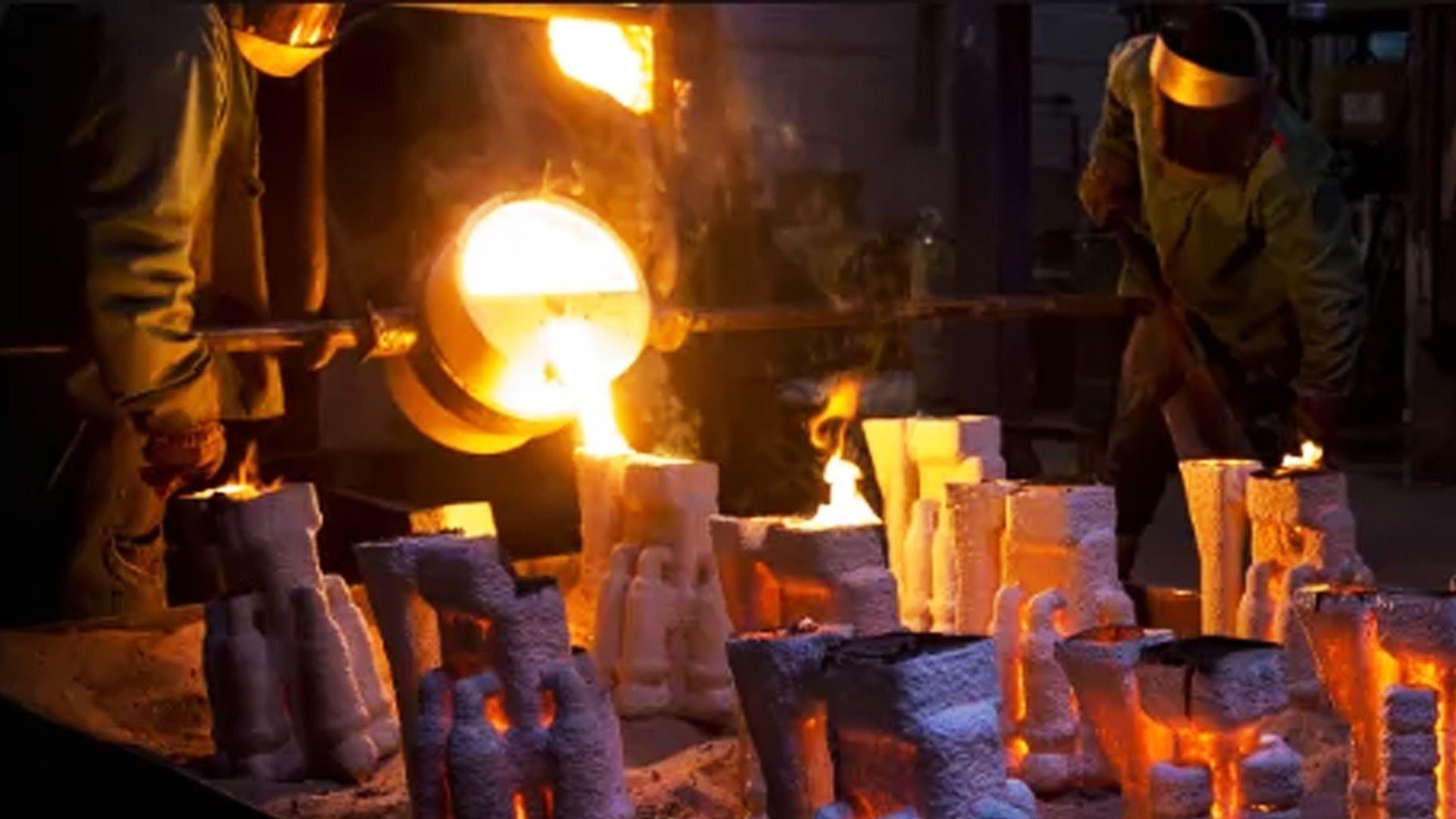The main differences in chemical composition between cast iron and cast steel lie in their carbon content and the content of other alloying elements.
Cast iron is an iron alloy containing 2% to 4% carbon, while cast steel is a steel alloy with a lower carbon content, typically ranging from 0.2% to 1.5%.
First, What Is Cast Iron?
Cast iron is an iron alloy with 2% to 4% carbon, usually containing other elements such as silicon (Si), manganese (Mn), sulfur (S), and phosphorus (P). Based on differences in element content and composition, cast iron can be classified into the following types:
1.Gray Cast Iron:
Gray cast iron is the most common type of cast iron, with relatively high carbon (2%–4%) and silicon (1%–3%) contents. Its name comes from the gray fracture surface, which is caused by carbon existing in the form of graphite within the cast iron. Gray cast iron is typically used to manufacture machine tool beds, automobile engine blocks, and other large castings.
2.White Cast Iron:
White cast iron has a high carbon content (2%–3%) but a low silicon content (usually below 0.5%). It gets its name from the white fracture surface, resulting from carbon existing in the form of iron carbides. White cast iron is commonly used for making cutting tools and bearings.
3.Ductile Cast Iron (Nodular Cast Iron):
Ductile cast iron is a type of cast iron containing spherical graphite, with a carbon content typically between 2% and 4% and a silicon content below 1%. Its name comes from the spherical shape of the graphite, which is achieved by adding elements such as magnesium (Mg) or yttrium (Y) during the casting process. Ductile cast iron is often used to produce automotive parts, pipes, and other castings requiring high strength and wear resistance.
4.High-Alloy Cast Iron:
High-alloy cast iron is a type of cast iron with a high content of alloying elements, such as chromium (Cr), nickel (Ni), molybdenum (Mo), and titanium (Ti). It is usually used to manufacture parts that withstand high temperatures and corrosion, such as aircraft engine components and chemical equipment.
Then, What Is Cast Steel?
Cast steel is a steel alloy with a lower carbon content (typically 0.2%–1.5%), along with other alloying elements like chromium, nickel, molybdenum, and titanium. According to differences in element content and composition, cast steel can be categorized into the following types:
1.Carbon Cast Steel:
Carbon cast steel has a relatively high carbon content (0.2%–1.2%). It is commonly used to produce mechanical parts, tools, and other components requiring high strength and wear resistance.
2.Alloy Cast Steel:
Alloy cast steel contains alloying elements such as chromium, nickel, molybdenum, and titanium. It generally has higher strength, hardness, and corrosion resistance, making it suitable for manufacturing aircraft engine components, automotive parts, and other parts that demand high strength and corrosion resistance.
3.Stainless Cast Steel:
Stainless cast steel contains chromium, nickel, and other alloying elements, offering excellent corrosion resistance and high-temperature strength. It is typically used to make chemical equipment, food processing machinery, and other parts requiring high corrosion resistance.
4.High-Temperature Alloy Cast Steel:
High-temperature alloy cast steel includes alloying elements like chromium, molybdenum, tungsten (W), and others, providing good high-temperature strength and corrosion resistance. It is commonly used in the production of aircraft engine components, gas turbines, and other parts that need to withstand high temperatures and corrosion.
Beyond Chemical Composition: Other Key Differences
After understanding the compositional differences between cast iron and cast steel, they also differ in the following aspects:
1.Strength: Cast iron has lower strength, while cast steel has higher strength.
2.Toughness: Cast iron has poor toughness, whereas cast steel has better toughness.
3.Machinability: Cast iron is less machinable, while cast steel offers better machinability.
4.Corrosion Resistance: Cast iron has relatively poor corrosion resistance, while cast steel has better corrosion resistance.
Is Cast Iron Inferior to Cast Steel in Every Way?
Not at all! Cast iron has one major advantage: it is cheaper.
This is undoubtedly a crucial advantage in industrial applications that cannot be ignored.
The cost advantage of cast iron stems not only from the lower price of its raw materials but also from its lower manufacturing costs. The casting process for cast iron is relatively simple (e.g., sand casting or permanent mold casting) and low-cost.
In contrast, cast steel typically uses more complex casting processes such as investment casting (lost-wax casting) or vacuum casting, which are more expensive. However, cast steel parts produced this way have higher strength and toughness, making them suitable for high-strength, high-demand components.
Other Advantages of Cast Iron Over Cast Steel
Besides being cheaper, cast iron also outperforms cast steel in the following aspects:
1.Superior Castability: Cast iron has good fluidity, making it easy to cast into parts with complex shapes. Additionally, it has a low shrinkage rate, reducing the risk of defects like shrinkage cavities and porosity.
2.Excellent Wear Resistance: The high carbon and silicon contents in cast iron give it good wear resistance, making it suitable for applications requiring wear resistance.
3.Good Damping Capacity: Cast iron has excellent damping performance, making it ideal for applications that need vibration reduction.
Summary
The biggest advantages of cast iron over cast steel are its lower material cost and lower manufacturing cost.
Cast iron is suitable for applications requiring low strength, low toughness, and low cost. Cast steel, on the other hand, is used for applications demanding high strength, high toughness, and can accommodate higher costs. Even so, cast iron still excels in wear resistance and damping capacity.

